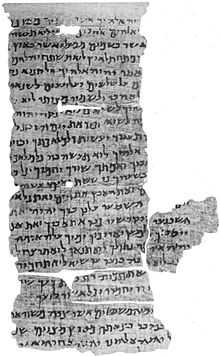Nash Papyrus

The Nash Papyrus is a collection of four papyrus fragments acquired in Egypt in 1898 by W. L. Nash, the secretary of the Society of Biblical Archaeology. He presented them to Cambridge University Library in 1903.[1] They comprise a single sheet and are not part of a scroll. The papyrus is of unknown provenance, although allegedly from Fayyum. The text was first described by Stanley A. Cook in 1903. Though dated by Cook to the 2nd century AD, subsequent reappraisals have pushed the date of the fragments back to about 150-100 BC. The papyrus was by far the oldest Hebrew manuscript fragment known at that time, before the discovery of the Dead Sea Scrolls in 1947.
Twenty four lines long, with a few letters missing at each edge, the papyrus contains the Ten Commandments in Hebrew, followed by the start of the Shema Yisrael prayer. The text of the Ten Commandments combines parts of the version from Exodus 20:2-17 with parts from Deuteronomy 5:6-21. A curiosity is its omission of the phrase "house of bondage", used in both versions, about Egypt — perhaps a reflection of where the papyrus was composed.
Some (but not all) of the papyrus' substitutions from Deuteronomy are also found in the version of Exodus in the Septuagint, a Greek translation of the Pentateuch from the 3rd-2nd centuries BC, made in Alexandria. The Septuagint also interpolates before Deuteronomy 6:4 the preamble to the Shema found in the papyrus, and additionally agrees with a couple of the other variant readings where the papyrus departs from the standard Hebrew Masoretic text. The ordering of the later commandments in the papyrus (Adultery-Murder-Steal, rather than Murder-Adultery-Steal) is also that found in most texts of the Septuagint.
According to the Talmud it was once customary to read the Ten Commandments before saying the Shema. As Burkitt put it, "it is therefore reasonable to conjecture that this Papyrus contains the daily worship of a pious Egyptian Jew, who lived before the custom came to an end".[2] It is thus believed that the papyrus probably consisted of a liturgical document, specifically the constituents of a Phylactery,[1] which may have purposely synthesised the two versions of the Commandments, rather than directly from Scripture. However, the papyrus' similarities with the Septuagint, support a possibility that a Hebrew text of the Pentateuch was in circulation in Egypt in the 2nd century BC, and served both the Nash papyrus and the Septuagint translation as source, but which differs significantly from the "modern" Jewish Masoretic Text.
See also
References
- Cook, Stanley A. "A Pre-Massoretic Biblical Papyrus." Proceedings of the Society of Biblical Archaeology 25 (1903): 34-56.
- Albright, William F. "A Biblical Fragment from the Maccabean Age: The Nash Papyrus." Journal of Biblical Literature 56 (1937): 145-176.
External links
- Nash Papyrus, Cambridge Digital Library
- Greenberg, Moshe, "Nash Papyrus" in Encyclopaedia Judaica, Vol.14, ed. Skolnik, Fred, et al. (Keter Publishing House, 2007), 783-784.
References
- ↑ 1.0 1.1 "Nash Papyrus". Cambridge Digital Library. Retrieved 18 December 2012.
- ↑ Burkitt, F.C., The Hebrew Papyrus of the Ten Commandments, The Jewish Quarterly Review, 15, 392-408 (1903)